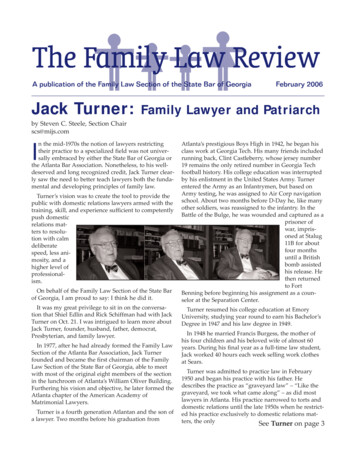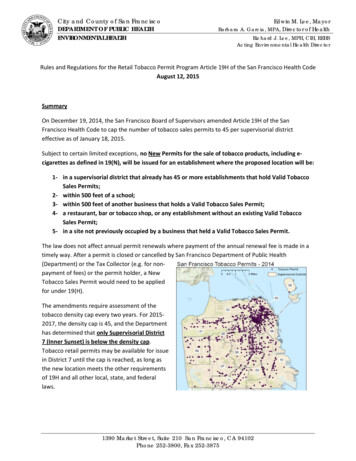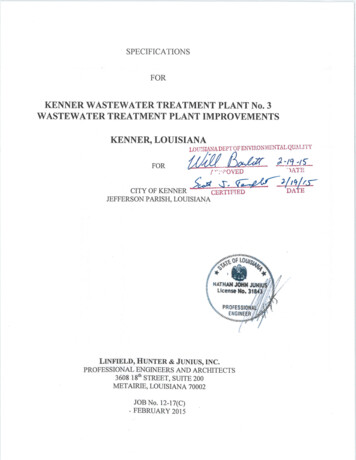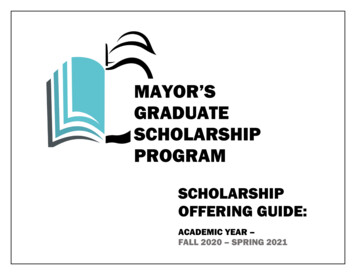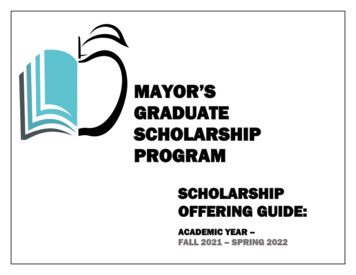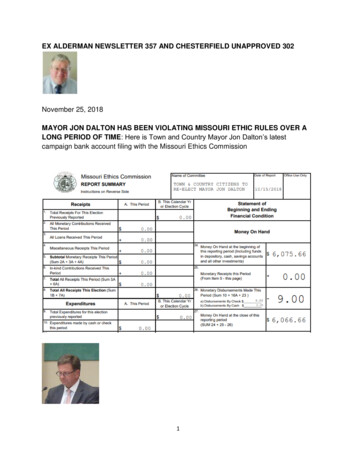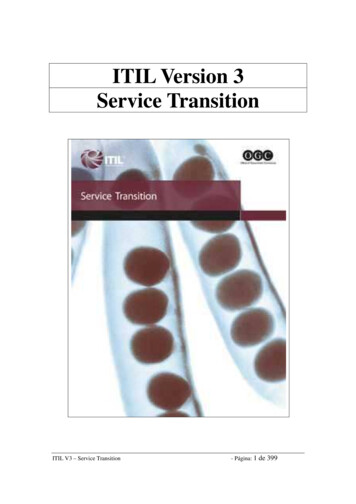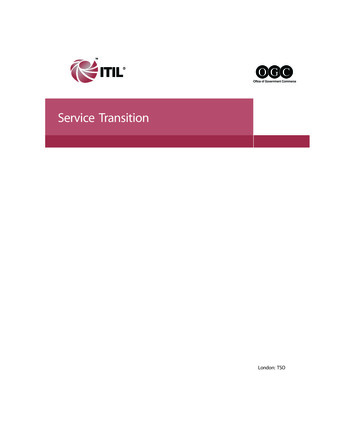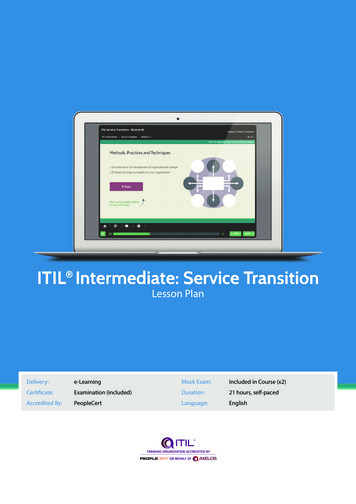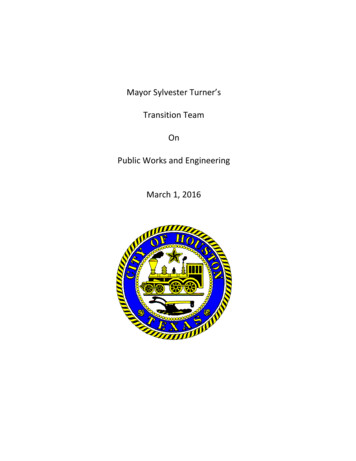
Transcription
Mayor Sylvester Turner’sTransition TeamOnPublic Works and EngineeringMarch 1, 2016
II.COMMITTEE MEMBERSHIPPeck BoswellBRH GarverJeff CollinsCivil Engineer, LJA EngineeringTony CouncilProfessional Engineer, TLC Engineering Inc. (Transition Committee Co-Chair)Jon DealPresident, TDC Realty LLCBecky EdmondsonPresident, Westbury Civic ClubPat FrazierCommunity Leader / TeacherMarlene GafrickPlanner, MetroNationalEddie GonzalezBusiness Representative, SMARTTony GonzalezCommercial General Contractor, The Gonzalez GroupLarry HuntProfessional Engineer, President, Hunt & Hunt Engineering Corp.Jessica JonesReliability Engineer; Dow ChemicalWayne KlotzProfessional Engineer, RPS Klotz Associates (Transition Committee Chair)Jeremy McFarlandResidential Architecture, Brick Moon DesignBen MendezFacilities Manager, MD AndersonGary MosleyDeveloper/Restaurateur/Pres., Creek Group RestaurantsSanjay RamVERSA GroupEpi SalazarProfessional Engineer, President SES Consulting EngineersJeff SantoriMarketing Rep/Recruiting Specialist, LiUNA/Midwest RegionBrian SmithBSCICalvin SpeightBusiness Manager Plumbers Local 68Ravi YanamandalaProfessional Engineer, Geotest EngineeringCarlos VillarrealAssistant Business Manager, I.B.E. W. Local 716Bobby SinghProfessional Engineer, Isani Consultants, Executive Transition Team – Liaisonto PWESteve CostelloProfessional Engineer, Costello, Inc., Executive Transition TeamKathryn McNeilResourcePage 2
III.EXECUTIVE SUMMARYThe Public Works and Engineering Transition Committee presents its findings to MayorSylvester Turner. We understand the importance of PWE to the City of Houston, and we believethe recommendations in this report will improve transparency, efficiency, and accountability intheir operations.Recognizing the size of our assignment, the committee divided into 3 subcommittees to studyour three primary issues. Each subcommittee had its own chair, and all committee memberswere asked to volunteer to serve in the area of highest interest. Our committee report is acompilation of reports from the 3 groups, and all members of the committee had theopportunity to review and comment on its contents.Tony Council and Wayne Klotz appreciate the honor of leading this group. Please let us know ifwe can provide additional information or answer questions.Page 3
III.EXECUTIVE SUMMARYORGANIZATION / OPERATIONS / PUBLIC ENGAGEMENT SUB-COMMITTEE REPORTThe Sub-Committee is addressing issues pertaining to –Public / Community engagement and perception of PWEOperational efficiency and timely delivery of core services and projects includingPermittingOrganizational Structure that facilitates collaboration and eliminates “Us vs. Them”mentality and redundancy.Recommendations to address major areas of concern to the public, communication andoperational efficiency are all rolled into Organizational Structure RecommendationsOrganization Structure (attached) addresses Communication, Permitting, Planning, andstreamlines delivery and implementation of core day-to-day services.Recognition that the best of Organization Structures is only as good as the spirit ofcollaboration (eliminating “Us vs. Them” internally and externally) and clear expectations/ accountability set by the leadership. The citizens of Houston have hired a TEAM and thatteam includes the Mayor, City Council, PWE AND external service providers to deliverPWE services.Consideration of a strong Executive Deputy Director position that will drive day-to-dayimplementation allowing PWE Director to focus on long-range issues, strategic initiativesmega projects and internal/external communication.Elevating “Communication” to a Deputy Director position to focus on public engagementas well as inter-agency/media/internal communicationRe-aligning the Planning & Development Division to focus on Permitting & Developmentand moving the “Planning” function to appropriate Divisions.Traffic & Transportation – Identified by Houstonians as a major problem facing the region,elevating this issue and having a MOBILITY Commission in the Mayor’s Office isrecommended. Having a Houston Mobility Commission that is tasked with policydecisions impacting regional multi-modal transportation issues and inter-agencycollaboration across governmental lines.Page 4
III.EXECUTIVE SUMMARYPERMITTING SUB-COMMITTEE REPORTThe Permitting Sub Committee reviewed building plan review quality and timing, inspections andcustomer service impact on construction projects within the city.Plan Review - Quality of Review and TimingEstablish quality of review standards for reviewing a set of plans.Establish a maximum number of days each group within plan review has to review a set ofplans.Streamline operations to increase capacity.Create a stakeholder committee that meets quarterly with the Deputy Director toimprove permit process.InspectionsProvide consistency in inspection.Repair the inspection notification system.Allow outside inspections for foundation and pier on single family residential projects.Customer ServicePlan review and the Houston Permit Center should report to a Deputy Director whoseprimary job is Plan Review and the Permit Center.Provide greater customer accessibility to employees.Establish a “Customer Liaison Group” that resolves complaints, discrepancies and issues.SoftwareHold customer workshops.Review permit fees.Page 5
III.EXECUTIVE SUMMARYCONTRACTS SUB-COMMITTEEThe Contracts Sub Committee is addressing the issue of firms having an equal chance to competein Professional Services Procurement and Construction Contracting.Professional Services RecommendationsMeeting of all stakeholders on Level of EffortChange in procurement method and scheduleConstruction Contracting RecommendationsWorkforce DevelopmentImproving Contracting ProcessThe Sub Committee met with PWE Director Dale Rudick and his staff to discuss contractingissues. Director Rudick and staff provided information on current contracting process andproposed improvements. Ideas to improve process were discussed by the Sub Committeemembers and the City PWE was open to make changes in a phased manner.Page 6
IV.ISSUE ANALYSISORGANIZATION / OPERATIONS / PUBLIC ENGAGEMENTSUB-COMMITTEESanjay Ram, ChairPeck BoswellBecky EdmondsonJessica JonesCalvin SpeightBen MendezBrian SmithCommunication – Based on feedback, there is a definite opportunity for better communication.Elevating this to a Deputy Director position will convey to all stakeholders that “Communication”is being given the importance it deserves. It is recommended that this role focus on four (4)distinct areas –Communication with citizens – in general and specifically on projects with a focus oncustomer serviceInter-Agency communications (with TxDOT, HCFCD, METRO etc.)Media communications – utilizing the media as a resource in educating the public oninfrastructure issues and not just during emergencies / problems.Internal / Business Communication –Between PWE Divisions (“Division” by definition promotes “Us Vs. them”) andwith other City Departments.Communication with Mayor and City CouncilCommunication with Service providers and Customers.Need for a Chief Operating Officer Type Role – Recognizing that PWE is a large, complex entitywith multiple functions; there are significant demands and distractions on a daily basis for thePWE Director. Having a strong Executive Deputy Director driving day-to-day PWE functionswould greatly help the PWE Director effectively address the strategic issues of PWE. An exampleof demands on time could be a waterline break that could / should be handled by linemanagement. While this could be perceived as adding another layer of management, it wouldmake a big difference in improving the effectiveness and efficiency of PWE. While the ultimateresponsibility would reside with the PWE Director, the recommendation is –Director to focus on Policy, Strategic Initiatives, Public Engagement, Mega Projects, InterAgency initiatives and Long-Term Planning.Executive Deputy Director to focus on driving Day-to-Day Operations, CIP ProjectDelivery, and Routine PWE Functions.Page 7
Planning & Permitting – Among the most public faces of PWE is the Permitting Group. A reliableand predictable process that is efficient and timely is critical from multiple perspectives includingeconomic development. The current situation leaves a lot to be desired. Even the City’s CIPprojects face an uncertain and uphill process, let alone private developers’ / citizens’ projects.The City has a Planning Department that formally housed the Permitting Group. A Planning &Development Division within PWE is currently responsible for Permitting. The recommendationis two-fold –Move the Planning function of PWE to more appropriate Divisions – Utility Planning underthe Public Utilities Division and Infrastructure Planning (Roadway & Drainage) underRoadway & Drainage Division.The Real Estate Group under Planning & Development Division addresses two broad areas– Easement / Right-of-Way (R-O-W) and Joint Referral. The Easement / R-O-W function isbetter served under the Engineering & Construction Division and currently has asignificant adverse impact on project delivery timeframes. The Joint Referral process isbetter served under Economic Development than under PWE.The above change allows for a singular focus for the Permitting/Development Division(under PWE) – to provide a consistent, predictable, reliable and timely permittingprocess. While moving the Permitting Group back to the Planning Department wasconsidered, it is not recommended as there are multiple essential functions to theprocess that are inherent to PWE.Mobility – Identified by Houstonians as a major problem facing the region, elevating this issue tothe Mayor’s Office by means of a Mobility Commission is recommended. This position willcoordinate mobility planning with PWE as well as with other agencies impacting regionaltransportation and mobility such as METRO, GCRD, Port of Houston, HCTRA, cyclists, pedestrians,parking, etc. The engineering and operation functions associated with roadway and drainage areto remain within PWE.Project Delivery under Engineering & Construction Division – The timeframe for CIP projects togo from planning to design to construction can be improved. Having a “Project ManagementOffice (PMO)” within ECD that drives project delivery could significantly enhance project deliverytime frames and also benefit from the same personnel being involved in managing projectdelivery from start to finish.The City Departments Involved in Implementing this Recommendation Would Include PWE &Economic Development (for Joint Referral). No changes in laws are anticipated to implementthese recommendations. While the addition of an Executive Deputy Director Role and elevatingCommunications to a Deputy Director position require additional expenditure, there are enoughefficiencies that can be gained elsewhere within PWE for these recommendations to beExpenditure Neutral & Efficiency Positive.Page 8
Page 9
Page 10
IV.ISSUE ANALYSISPERMITTING SUB-COMMITTEE REPORTSUB-COMMITTEEGary Mosley, ChairJon DealMarlene GafrickEddie GonzalezTony GonzalezLarry Hunt, P.E.Jeff SantoriThere is a general consensus among the building industry from interior remodelers, homebuilders and commercial builders that improvements can be made to plan review andinspections that will improve the quality of the review, reduce the review time and improvecustomer service.Plan Review IssueRecommendation 1 – Establish a quality of review standard for a set of plans. This in partcan be accomplished by having the same plan reviewer on a set of plans and training onthe code.Recommendation 2 – Establish a maximum timeframe for each plan review group toachieve the maximum amount of times a set of plans will be within the review system.Recommendation 3 – Streamline operations by eliminating bottlenecks and unnecessarysteps, such as, expanding the eligibility of project going through “One Stop”, allowinginterior remodels that are less than 25% of the building to bypass the Flood Permit Officeor expanding a list of projects that can bypass the Planning Department. City constructionprojects that have been reviewed and approved by the Engineering and Constructionshould not be required to also go through the permitting process.Recommendation 4 – Create a stakeholder committee that represents the buildingindustry, such as, Greater Houston Builder’s Association, Restaurant Industry, AssociationGeneral Contractors, Houston Real Estate Council, Gulf Coast Building and Trades andBuilding Owners and Managers Association. The purpose is to meet quarterly with theDeputy Director to discuss recommendations for improvements to plan review,permitting and inspections. An option is to explore expanding the Construction IndustryCouncil’s duties and membership.Inspections – There is inconsistency among inspectors on what meets the code. Work is builtaccording to approved plans and must be redone and the customer must pay a tradesman tostay at a job site until the inspection is completed. This is gets expensive for a customer to payhourly for a tradesman to wait all day for the inspection. The current notification process needsto be repaired and improved.Page 11
Recommendation 1 – Provide consistency in inspections through training and having thesame structural inspector from the first structural inspection through the final inspection.Ideally it would be great to have the same four inspectors through the whole process.Randomly follow-up on inspectors to provide quality assurance on the inspections.Recommendation 2 - Repair the inspection notification system that provides notice whenan inspection will be in the morning or afternoon. Ideally, with a new permit system,customers would be given a 2 hour window.Recommendation 3 – Allow outside inspections for foundation and pier on single familyresidential projects to eliminate duplication of city inspections when the foundation andpiers are required to be engineered and sealed by a licensed engineer. This engineerinspects the foundation before it is poured. Other cities have eliminated their inspectionswhen the foundation is inspected and certified by a licensed engineer.Customer Service – The permit is buried within Public Works and Engineering. Employees needto be empowered to carry out their job duties that are responsive to customer service. Softwareimprovements were promised with the 2009 fee increase that were not implemented.Recommendation 1 – The Houston Permit Center and all of Building Permit review,approval and inspections should report to a Deputy Director whose primary responsibilityis this program.Recommendation 2 – Provide greater customer access to plan reviewers by establishingstandards for returning phone calls and returning emails, such as, all phone calls will bereturned within 24 hours.Recommendation 3 – Establish a “Customer Liaison Group” that reports to the DeputyDirector. This group is charged with the responsibility to resolve complaints, discrepanciesand issues.Recommendation 4 – Hold a series of workshops for customers to inform them of codechanges and interpretations.Recommendation 5 – The ILMS is an antiquated system that needs to be replaced.Determine the appropriate software that will improve the overall user experience thatallows for the sharing of information between everyone in the permitting process and thecustomer.Recommendation 6 – Consider reviewing the fees since the last fee analysis was severalyears ago. This fee increase received support from the permitting community to cover thecost of service and a new software system. To gain support for increase fees, there aremany low hanging fruits that can be improved upon without a new system. Specialattention should be paid to the staffing levels in the Health Department and FireDepartment plan review groups. Their plan reviewers are also inspectors and as a resultthis causes significant delay in getting plans reviewed.Page 12
IV.ISSUE ANALYSISCONTRACTS REPORTSUB-COMMITTEERavi Yanamandala, P.E.Tony Council, P.E.Jeff Collins, P.E.Pat FrazierCarlos F. VillarrealEpi Salazar, P.E.Professional Services ProcurementLevel of Effort – Many prime design consultants and sub consultants (including geotechnical,surveying, environmental, etc.) feel that improvements need to be made in defining scope andeffort to make it fair and reasonable process per the Texas Engineering Procurement Act. Thiswill benefit local, small and MWDBE firms as it will allow more consistency and understandingbetween PWE staff and consultants.Recommendation 1 - A series of workshops with prime consultants, sub consultants, andthe City of Houston staff to resolve these issues. These workshops are expected todevelop consistency, understanding and forge effective partnerships between PWE staff,consultants, and sub consultants.Procurement Schedule – Current procurement of all CIP selections during one time of the yearresults in difficult staffing demands for PWE and consultants and delays during contractnegotiations, award and project execution.Recommendation 1 – Consider increasing selection of prime firms based on PWE 100Qualification Statements. After selection, prime firms would submit a list of potential subconsultant firms for concurrence by the City. This selection method is similar to HarrisCounty Engineering Department procurement model. This method also eliminates thecurrent requirement to prepare and submit additional qualification statements. This willstreamline the solicitation process.Recommendation 2 – An alternate model recommended is to procure professionalservices 4 times/year. TxDOT utilizes this model to procure professional services. Thismodel offers adequate review time for staff.The above procurement alternates would expedite selections, contract, legal processes andaward times. These alternates will also enable firms to better plan which projects to pursue andto more efficiently allocate resources. This will also reduce overload in PWE, legal and otherrelated city departments by staggering them throughout the year.Recommendation 3 – Another method to improve PWE contracting outcomes is toevaluate a program geared towards Small Businesses (based on revenue) as primecontractors.Page 13
Construction ProcurementWorkforce Development Opportunities - Current contracting practices do not encourage orfacilitate opportunity through responsible contracting to connect people most in need to on thejob training and a career in construction. Responsible contracting can be achieved throughordinances, laws, regulations or administrative policies.Recommendation 1 – Pre-qualify contractors that utilize “earn while you learn” registeredapprenticeship training programs with the Department of Labor (DOL) (insurersoversight). Appoint a point person at the city or partner with workforce solutions toassist SMWDBE contractors with job fairs to hire from designated zip codes and conductworkshops and training to meet Section 3 certifications and requirements.Recommendation 2 – Set goals around a percentage of workforce on public constructionprojects. This local targeted workforce should include potential employees that areregistered DOL apprentices, veterans, second chance workforce and people from zipcodes with the highest unemployment similar to Housing Authority Section 3Requirements (Ex. Seattle Ordinance)Improving Contracting Process - Current process should have greater transparency,accountability and standards on the front end to avoid change orders and substandard work.The pre-qualification process is designed to reduce safety and prevailing wage violations, andensure that publicly funded construction contracts go to firms with strong safety and qualityrecords.Recommendation 1 – Pre-qualify and only allow contractors who meet minimumstandards to bid. Qualification criteria to include:No wage / hour violations in past 3 yearsProvide OSHA 10-hour safety trainingPay prevailin
Calvin Speight Business Manager Plumbers Local 68 Ravi Yanamandala Professional Engineer, Geotest Engineering Carlos Villarreal Assistant Business Manager, I.B.E. W. Local 716 Bobby Singh Professional Engineer, Isani Consultants, Executive Transition Team – Liaison to PWE



